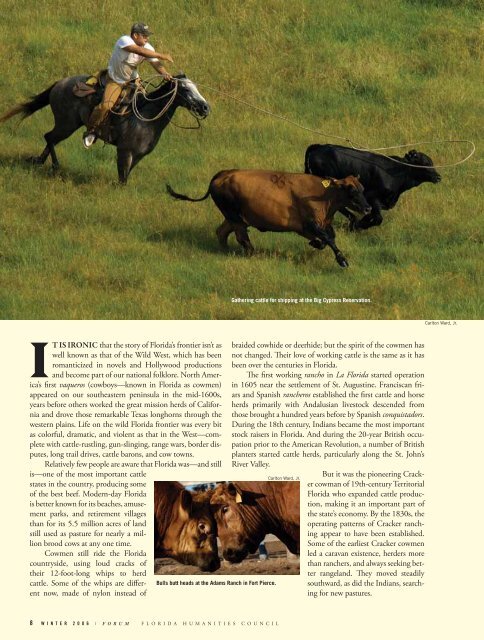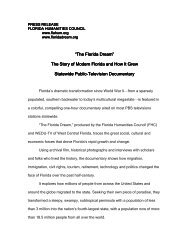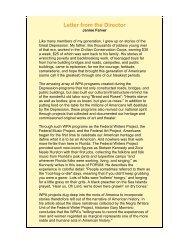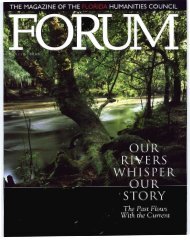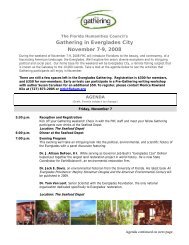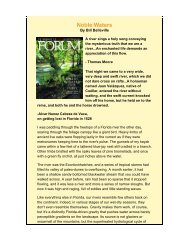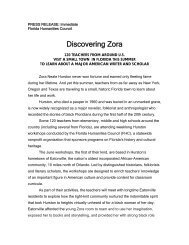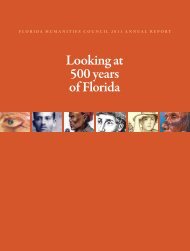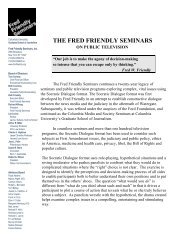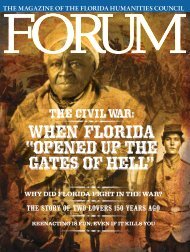THE MAGAZINE OF THE FLORIDA HUMANITIES COUNCIL
THE MAGAZINE OF THE FLORIDA HUMANITIES COUNCIL
THE MAGAZINE OF THE FLORIDA HUMANITIES COUNCIL
You also want an ePaper? Increase the reach of your titles
YUMPU automatically turns print PDFs into web optimized ePapers that Google loves.
It iS iRonic that the story of Florida’s frontier isn’t as<br />
well known as that of the Wild West, which has been<br />
romanticized in novels and Hollywood productions<br />
and become part of our national folklore. North America’s<br />
first vaqueros (cowboys—known in Florida as cowmen)<br />
appeared on our southeastern peninsula in the mid-1600s,<br />
years before others worked the great mission herds of California<br />
and drove those remarkable Texas longhorns through the<br />
western plains. Life on the wild Florida frontier was every bit<br />
as colorful, dramatic, and violent as that in the West—complete<br />
with cattle-rustling, gun-slinging, range wars, border disputes,<br />
long trail drives, cattle barons, and cow towns.<br />
Relatively few people are aware that Florida was—and still<br />
is—one of the most important cattle<br />
states in the country, producing some<br />
of the best beef. Modern-day Florida<br />
is better known for its beaches, amusement<br />
parks, and retirement villages<br />
than for its 5.5 million acres of land<br />
still used as pasture for nearly a million<br />
brood cows at any one time.<br />
Cowmen still ride the Florida<br />
countryside, using loud cracks of<br />
their 12-foot-long whips to herd<br />
cattle. Some of the whips are different<br />
now, made of nylon instead of<br />
Bulls butt heads at the Adams Ranch in Fort Pierce.<br />
1 8 W I N T E R 2 0 0 6 / F O R U M F L O R I D A H U M A N I T I E S C O U N C I L<br />
Gathering cattle for shipping at the Big Cypress Reservation.<br />
braided cowhide or deerhide; but the spirit of the cowmen has<br />
not changed. Their love of working cattle is the same as it has<br />
been over the centuries in Florida.<br />
The first working rancho in La Florida started operation<br />
in 1605 near the settlement of St. Augustine. Franciscan friars<br />
and Spanish rancheros established the first cattle and horse<br />
herds primarily with Andalusian livestock descended from<br />
those brought a hundred years before by Spanish conquistadors.<br />
During the 18th century, Indians became the most important<br />
stock raisers in Florida. And during the 20-year British occupation<br />
prior to the American Revolution, a number of British<br />
planters started cattle herds, particularly along the St. John’s<br />
River Valley.<br />
But it was the pioneering Crack-<br />
Carlton Ward, Jr.<br />
er cowman of 19th-century Territorial<br />
Florida who expanded cattle production,<br />
making it an important part of<br />
the state’s economy. By the 1830s, the<br />
operating patterns of Cracker ranching<br />
appear to have been established.<br />
Some of the earliest Cracker cowmen<br />
led a caravan existence, herders more<br />
than ranchers, and always seeking better<br />
rangeland. They moved steadily<br />
southward, as did the Indians, searching<br />
for new pastures.<br />
Carlton Ward, Jr.


